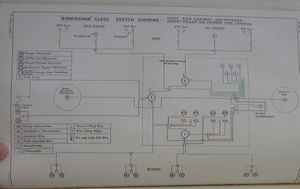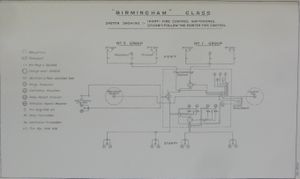Birmingham Class Cruiser (1913)
Three of the four light cruisers of the Birmingham Class were completed in 1914, but Adelaide was completed in 1922.
They were sometimes treated as the third sub-type of an encompassing "Town Class" which included the five earlier Bristol, four Weymouth, and six Chatham class as well as the following two Birkenhead class cruisers.
| Overview of 4 vessels | |||||
|---|---|---|---|---|---|
| Citations for this data available on individual ship pages | |||||
| Name | Builder | Laid Down | Launched | Completed | Fate |
| Birmingham | Armstrong, Whitworth & Company | 10 Jun, 1912 | 7 May, 1913 | Feb, 1914 | Sold 5 Feb, 1931 |
| Lowestoft | Chatham Royal Dockyard | 29 Jul, 1912 | 23 Apr, 1913 | Apr, 1914 | Sold 8 Jan, 1931 |
| Nottingham | Pembroke Royal Dockyard | 13 Jun, 1912 | 18 Apr, 1913 | Apr, 1914 | Torpedoed 19 Aug, 1916 |
| Adelaide | Cockatoo Dockyard | Jan, 1915 | 27 Jul, 1918 | Aug, 1922 | Sold Jan, 1949 |
Armament
The ships were armed as follows.[1]
Guns
- Nine 6-in 45cal B.L. Mark XII guns on P. VII mountings[2] (Adelaide may have had P. XIII[3]); 4 on each broadside and 1 on centreline aft.
- Four 3-pdr
Immediately before the start of war, screw-on covers to protect the cams of the 6-in guns were to be ordered for installation at Portsmouth Royal Dockyard.[4]
In 1915, all received a 3-in 20cwt Mark I gun on H.A. mounting on a centreline platform abaft the funnel.
Torpedoes
- Two 21-in submerged broadside tubes
Fire Control


Mechanical Aid-to-Spotter
By 1920, the two extant ships were equipped with Mechanical Aid-to-Spotter Mark II*s with Evershed Bearing Transmitters.[7] The installations generally consisted of placing one on each side of the foretop, driven by flexible shafting from a gearbox on the director tower's Evershed rack.[8]
Supplies of these instruments began in June 1918.[9]
Range Dials
In 1918, it was ordered that these and ten other classes of light cruisers should receive "range instruments for concentration of fire". Presumably, this meant range dials.[10]
As of 1920, the two extant vessels Birmingham and Lowestoft were each equipped with two Range Dial Type Cs, and Adelaide was intended to, also.[11]
Rangefinders
By June 1918, it was determined that the "Town" class cruisers would probably eventually carry two 12-foot and one 9-foot rangefinders.[12]
By 1921, the ships were equipped as follows:[13]
- Fore bridge: 12ft F.Q. 2 on M.P. 2 mounting
- After control: 12ft F.Q. 2 on M.P. 2
- High Angle: 1m F.T. 28 on M.T. 9
Evershed Bearing Indicators
This equipment was unlikely to have been fitted for gun or searchlight control.[14]
Gunnery Control
Control Positions
There was a control top and a control platform aft with a navyphone connection between them. Both positions enjoy voicepipe connection to the T.S..[15]
Control Groups
Each broadside was arranged in 2 groups of 2 guns each. The CL gun aft was a separate group that can be operated independently or assigned to one of either aft broadside group by a C.O.S.[16]
Three 2-way change-over switches in the T.S. route signals:
- One is fitted in No. 1 group (forward) starboard guns circuit
- One is fitted in No. 1 group (forward) port guns circuit
- One assigns the aft CL gun to port or starboard after group's circuit
When change-over switches 1 or 2 are in their first position, the forward group is worked by its own panel of transmitters in the TS. In position 2, the forward group it is wired to is worked jointly with the aft group on the same broadside. That is, the settings are "split the broadside" or "work the fore group with the aft group".
Navyphones are also controlled by the same C.O.S. system, with telaupads at each gun. Five navyphones are in the TS to address the guns. A pair of navyphones were directly wired between the control top and the after control platform, and both platforms communicated to the T.S. by voicepipe.[17]
Directors
In 1916, it was approved that the ships of this class should be retrofitted with directors as time, resources and opportunity permitted.[18]
Birmingham and Lowestoft were probably fitted with directors in 1917 and 1918,[19] though Conway's indicates that Birmingham received hers in 1916-17 and Lowestoft received a new light pattern director in December, 1914.[20] It is almost certain that Adelaide completed with one in place, as she was completed in 1922.
In late 1917, it was intended that Adelaide was to feature 6-in P. XIII Type Elevation Receivers with electrical tilt correction capable of indicating 30 degrees elevation, Pattern V.E. 1. Her Small Type Training Receivers were pattern number 20 on P1 to P3 and S1 to S3, whereas P4, S4 and #5 had pattern number 21.[21]
For Birmingham and Lowestoft, the Elevation Receivers were 6-in P. VII Type with electrical tilt correctors, capable of indicating up to 15 degrees of elevation, Pattern H. 20. Their Small Type Training Receivers were pattern number 22 on P1 to P3 and S1 to S3, whereas P4, S4 and #5 had pattern number 23.[22]
Transmitting Stations
There was a single T.S. with navyphones, 3 C.O.S. and 4 sets of transmitters with fire pushes.[23]
Dreyer Table
These ships had no fire control tables.[24]
Fire Control Instruments
Vickers F.T.P. instruments, presumably Mark III.[25][Inference]
By mid-1918, it had been approved to issue these ships, along with several other classes of light cruisers range repeat receivers for their fore bridge and control positions so that their captains and control officers could know the gun range. Additionally, the "Town" class cruisers were to receive two "Graham type" bearing transmitters in their spotting tops.[26]
Torpedo Control
In 1916, it was decided that all light cruisers of Bristol class and later should have torpedo firing keys (Pattern 2333) fitted on the fore bridge, in parallel with those in the CT, and that a flexible voice pipe be fitted between these positions. Additionally, those with submerged tubes were to be equipped with gyro angle and order instruments from fore bridge (and after control position, if present) to the tubes. Birmingham class, if we infer it to be part of the Chatham class mentioned in the source, already has (or will have) Barr and Stroud for this purpose.[27]
In mid-1920, it was decided that Birmingham and Lowestoft should each receive a Renouf Torpedo Tactical Instrument Type A. Adelaide appears to have been omitted,[28] but she was added a year later.[29]
See Also
Footnotes
- ↑ Conway's All the World's Fighting Ships 1906–1921. p. 54.
- ↑ The Sight Manual. 1916. p. 66.
- ↑ The Director Firing Handbook. p. 144.
- ↑ Admiralty Weekly Order No. 176 of 24 July 1914.
- ↑ Annual Report of the Torpedo School, 1913. Plate 63.
- ↑ Handbook for Fire Control Instruments, 1914. Plate 98.
- ↑ Manual of Gunnery (Volume III) for His Majesty's Fleet, 1920. p. 35.
- ↑ Manual of Gunnery (Volume III) for His Majesty's Fleet, 1920. p. 35, 37.
- ↑ The Technical History and Index, Vol. 3, Part 23. pp. 25-6.
- ↑ Annual Report of the Torpedo School, 1918. p. 376. (C.I.O. 3492/18, N.S. 11226/18).
- ↑ Manual of Gunnery (Volume III) for His Majesty's Fleet, 1920. p. 45.
- ↑ Grand Fleet Gunnery and Torpedo Orders. 21/6/1918, p. 116.
- ↑ Handbook for Naval Range-Finders and Mountings, Book I. p. 168.
- ↑ The Technical History and Index, Vol. 3, Part 23. p. 29.
- ↑ Handbook for Fire Control Instruments, 1914. p. 65.
- ↑ Handbook for Fire Control Instruments, 1914. p. 65.
- ↑ Handbook for Fire Control Instruments, 1914. Plate 63.
- ↑ Annual Report of the Torpedo School, 1916. p. 175.
- ↑ The Technical History and Index, Vol. 3, Part 23. pp. 11-12.
- ↑ Conway's All the World's Fighting Ships 1906–1921. p. 54.
- ↑ The Director Firing Handbook. pp. 144-146.
- ↑ The Director Firing Handbook. pp. 144-146.
- ↑ Handbook for Fire Control Instruments, 1914. p. 65.
- ↑ absent from list in Handbook of Capt. F.C. Dreyer's Fire Control Tables, p. 3.
- ↑ Handbook for Fire Control Instruments, 1914. p. 65.
- ↑ Annual Report of the Torpedo School, 1917. p. 230.
- ↑ Annual Report of the Torpedo School, 1916. p. 146.
- ↑ Annual Report of the Torpedo School, 1919. p. 119.
- ↑ Annual Report of the Torpedo School, 1920. p. 91.
Bibliography
- H.M.S. Vernon. (Feb 1914) Annual Report of the Torpedo School, 1913, with Appendix (Wireless Telegraphy). Copy 42 at The National Archives. ADM 189/33.
- Admiralty, Gunnery Branch (1910). Handbook for Fire Control Instruments, 1909. Copy No. 173 is Ja 345a at Admiralty Library, Portsmouth, United Kingdom.
- Admiralty, Gunnery Branch (1914). Handbook for Fire Control Instruments, 1914. G. 01627/14. C.B. 1030. Copy 1235 at The National Archives. ADM 186/191.
- Admiralty, Gunnery Branch (1918). Handbook of Captain F. C. Dreyer's Fire Control Tables, 1918. C.B. 1456. Copy No. 10 at Admiralty Library, Portsmouth, United Kingdom.
- Admiralty, Technical History Section (1919). The Technical History and Index: Fire Control in H.M. Ships. Vol. 3, Part 23. C.B. 1515 (23) now O.U. 6171/14. At The National Archives. ADM 275/19.
| Birmingham Class Light Cruiser | |||||||||||||||||||||||||||||||||||||||||||||||||||||||||||||||||||||||||||||||||||||||||||||||||||||||||||||||||||||||
| Birmingham | Lowestoft | Nottingham | Adelaide | ||||||||||||||||||||||||||||||||||||||||||||||||||||||||||||||||||||||||||||||||||||||||||||||||||||||||||||||||||||
| <– | Chatham Class | Minor Cruisers (UK) | Arethusa Class | –> | |||||||||||||||||||||||||||||||||||||||||||||||||||||||||||||||||||||||||||||||||||||||||||||||||||||||||||||||||||